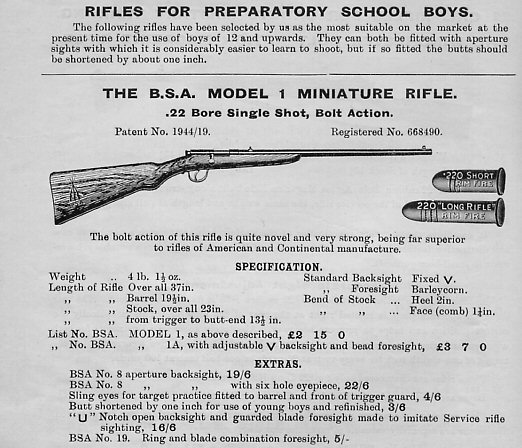THE B.S.A. MODEL No. 1 TARGET & SPORTING RIFLES
Please be aware that some specialist imagery may take time to load.
This site is designed for dedicated researchers, and is best viewed on desktop.
See also: ......BSA MODELS 2 & 3 ......
A late model example is shown below, with the folding B.S.A. No.8 aperture rear-sight ( lowered) and the No.19 tunnel fore-sight with the "L" formed dual tip-over element system permitting use of either a blade or a ring fore-sight. The later design of bolt and locking system is thus here illustrated. ( see further notes below). The barrel and action are a one-piece unit.

Introduced in 1908, the Model No.1 rifle was a target rifle in the minimal
sense. It, and its bolt action successors to the BSA range of .22 rimfire
rifles, could quite reasonably have been considered to be more of a sporting
nature in appearance - indeed, in later years that is more or less where it,
and the following Model No.2, eventually fell in the marketing scheme of things
once they were superseded by the more accurate Martini actioned rifles. Nonetheless,
at a time when there was a growing market for economically priced small-bore
rifles, the Model No.1 was both intended, and destined, to fall into the category
of a training and target rifle. Indeed, it was advertised specifically as
being suitable for use by twelve-year-olds, particularly for school or cadet
use. 
This put the Model No.1 squarely in competition with the War Office Pattern Miniature rifle, which rifle was designed at the Government's and War Office behest for precisely such purpose, and modelled upon the Short Magazine Lee-Enfield (SMLE) Service rifle also only recently brought into service in significant numbers at that time. The W.O.P. rifle, also manufactured initially by BSA, and latterly additionally by the London Small Arms Company, came to the market in 1906. BSA obviously felt that there was a market niche for a more basic rifle with lower manufacturing costs. The W.O.P. rifle had a comparatively complex bolt with its own safety, along with a tangent leaf rear-sight emulating that of the SMLE not only in appearance, but also in use and probably expense of production, the volumes being far less than those of the service rifle. The new civilian styled No.1 Model had none of this complexity and consequently could be sold at £1:15s ( one pound, fifteen shillings - or £1.75 at todays rates). The one significant aspect carried over to the Model No.1 and the No.2 rifles was the B.S.A. patented bolt-head with the hooded extractor - Pat. No. 14373 of 1907. The W.O.P. rifle cost nearly half as much again to manufacture
. A contemporary of these rifles, The Vickers Armstrong Martini Mark II rifle, which company had already earned a fine reputation for the accuracy of their barrels, cost an astonishing £5:0s:0d.
Interestingly, only one year later, by 1910, the BSA Model No. 2 had been introduced only a short while. At this point, BSA manage to market the No.2 at only £1:10s:0d ( £1.50 ) whilst the W.O.P. rifle was still selling for around £2:5s:0d ( £2.25 ) in its most basic form.
The Model 1 was still being advertised in 1919 ( advertisement below), through the 1920s, and still immediately pre-World War II as a .22RF rifle and a smooth-bore No.1 shot or BB capable garden gun.

The advertisement below is from a BSA brochure of around 1932 at the time the BSA Model 15 was introduced

Both the Model No.1 and its follow-on equivalent of the Model No.2 were still on offer in the mid 1950s in slightly modified form (the bolt and bolt-handle arrangement was altered so that only the handle and its boss rotated on locking, rather than the whole bolt body) as the BSA "Sportsman" single-shot rifle. That rifle was then also marketed with a five-round box magazine as the "Sportsman Five" and, with a tubular magazine, as the "Sportsman Ten & Fifteen" models. By then, there was competiton in the area of economically priced single-shot .22RF target and sporting rifles, from a number of German manufacturers such as J.G.A, Geco, Paatz and indeed Mauser, although their rifles were priced nearer to the cost of the American repeating .22RF rifles, close on £20.00 rather than the £5 to£10 asked for the other manufacturers' single-shot examples.
 Alongside
left is a comparison image of the early bolt, with the War Office Pattern
type B.S.A. designed and patented bolt-head with (bottom) the hooded extractor,
and (top) the later bolt, only the handle and boss of which rotates to lock
the action. The two actions can be seen below viewed from above.
Alongside
left is a comparison image of the early bolt, with the War Office Pattern
type B.S.A. designed and patented bolt-head with (bottom) the hooded extractor,
and (top) the later bolt, only the handle and boss of which rotates to lock
the action. The two actions can be seen below viewed from above.

Below, barrel markings are very similar to those of the War Office Pattern Miniature rifle and, there still, are the familiar "Piled Arms", the motif of the Birmingham Small Arms Company.

The photograph below of a cased Model No., 1 in DeLuxe form, has a most interesting history.

This BSA Model 1 target rifle, an example built by Alexander Martin of Glasow, is in its fitted case with all its accessories, including jags, brushes, cleaning rod and a small tin of bore-cleaning paste. It has a fold-down ring foresight, and a BSA No.8 fold-down rear sight. The gun was bought in 1909 for a 15-year-old boy who was to lose his life on the Somme barely a decade later. The rifle was passed to the present owner through the family.
Details and image kindly contributed by Terry A. de C. Foley
Return to: TOP of PAGE
See this website's Raison d'être